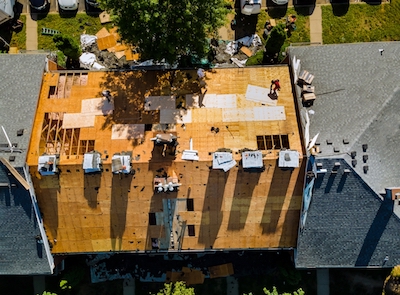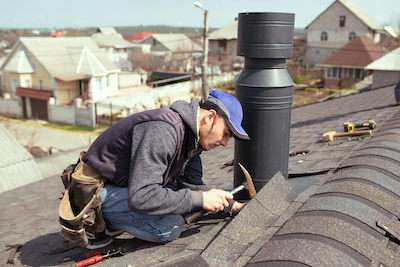When you purchase a house, it is always good to know how much it will cost to replace your roof. This is especially important if you are purchasing an older home. I have always wondered what it costs to put a roof on a house. So I did some research to prepare for this expense when it comes around.
So how much does a roof on a house cost? The national average for replacing a roof on a home is $8600. However, it can go as high as $45,000. The cost of replacing a roof includes the cost of materials and labor and this varies, as many factors go into determining the price of how much your roof might cost. These things include the geographic location of your house and the types of shingles you choose.
You cannot ignore your need for a new roof. If you need a new roof and do not make it a priority, you could be allowing additional damage to your home and inevitably decreasing your home’s value.
In this post, I will tell you about all the research I have done about the cost of roofing your home. As I was researching, I found so much information. I will be discussing the costs of roof replacement materials when you should replace your roof, how to reduce your costs, and how you can pay to replace your roof.

Roof Replacement: What Are You Paying For?
When you get your roof replaced, you might wonder what you are paying for. The cost to replace your roof is a significant investment, so I researched the details of what a professional roofer will actually be doing. The cost of replacing a roof includes the cost of materials and labor.
Some of the required materials you will be paying for include the underlayment. This is the barrier (waterproof) installed into the roof’s decking and this is needed before adding shingles.
Shingles are the material that you can see that covers the roof. Next, you will be paying for soffits. This is another type of barrier that protects the eaves of your home. When your soffits are damaged it affects your rafters. Your rafters are exposed to moisture and this will also impact the ventilation in your attic.
You will be purchasing the drip edge. This is a strip of material used to direct water off the roof onto the gutters. Lastly, you will be paying for flashing. This is placed in areas where the drip edge cannot go and its purpose is to redirect water.
You will also have to pay for labor. Labor costs can be very subjective based on the company you use. However, labor costs will include the removal or “tear-off” of the old roof. This includes disposal of the old roof and materials. Labor includes installing the new roof and cleanup. Other individual items on your roof, such as chimneys, skylights, and even the roof size, can change your labor costs.
When Should I Replace My Roof?
There are some clear indicators that your roof needs replacement. You will know that your roof needs to be replaced if you are:
- Losing shingles.
- If you have cracked shingles.
- If the edges of your shingles are curling.
- If you have water leaks.
- If you can see pooling water on your roof.
- If you can see damage to your roof deck.
You should pay for a professional roof inspection if you see any of these things on your roof. This will let you know if a roof repair or total replacement is necessary. Hiring a professional roof inspector can cost from $125 to $325, depending on the company. To determine when your roof should be replaced, you will need to examine the material your roof is made of.
Here are the main types of materials a roof is made of and how long they will typically last:
- Composition Shingles Last for 15-20 Years
- Asphalt Shingles Last for 15-30 Years
- Wood Shingles Last for 20-25 Years
- Rubber Roofs Last for 30-60 Years
- Metal Roofs Last for 50-75 Years

Tips to Reduce Roof Replacement Costs
Paying for a new roof is no small expense. While researching this topic, I also wanted to know how others find the money to do this. There are a few tips that I found which may be helpful.
1. Materials
You must know your roof replacement materials. Shingles are the most considerable material cost. Shingle’s price depends on your per-square basis. You will need to be mindful of the type of shingle you choose. One of the most cost-effective shingle materials is asphalt. The price of asphalt can average $2500 for 17 squares (the average number for a 2,200-square-foot house). These shingles are easy to install and last long. Another option is composition shingles (fiberglass coated with asphalt and minerals). These are also cost-effective. However, they are not as durable and might wear out faster. Metals like copper are one of the most expensive materials to use. It is durable but would cost $25,000 to use for a room in a 2,200-square-foot house (17 squares).
2. Wait for Discounts
Often companies will provide seasonal discounts. If you have the time and ability to wait until certain seasons roll around, it could save you loads of money! Summer and fall are the busiest seasons for roofers. During their slower seasons, there could be deals you could take advantage of. So think about getting your new roof in early to late winter or early to late spring.
3. Use Your Insurance
Check your homeowner’s insurance policy for roof coverage. It could be covered depending on your policy and why you need a new roof. The best way to start this process is to get a roofing company to come out and complete an inspection. Allow them to advise you if what your roof needs could be covered by insurance. Armed with that information and estimate, talk to your insurance company and start a claim if necessary.
4. Get More Than One Quote and Do Your Research
Get at least three quotes from professional roofing companies. Analyze the quotes and make sure they are all in similar ranges. A quote that comes in too low might not be the company to go with for this work. Look at the company’s reviews and pictures of work they have done similar to your job. Do not forget to verify that they have bond insurance and licensing before choosing a company or making any payments. Stay away from companies that require complete payment in advance. It is better to be safe than sorry!
Ways to Pay to Replace Your Roof
Paying to replace your roof is no small challenge. So, how do people manage it? Most people do not have the cash to splurge on replacing their roofs. In my research, I discovered a few ways most people can afford to pay to replace their roofs.
One way people can pay to replace their roofs is through personal loans. Personal loan terms tend to be very flexible, and you are able to select short or long terms. You typically have a fixed interest rate and will not have to supply collateral to the bank, such as your home. When using this type of financing, you must be careful of loan origination and closing fees.
Another way homeowners are able to pay to replace their roofs is by obtaining a home equity loan. This is a type of loan where you borrow based on the equity available in your home. Your home is the collateral. This is also known as a second mortgage. The interest with this type of loan may be tax-deductible.
Lastly, you can get a home equity line of credit or HELOC. This type of loan also allows you to borrow against the equity in your home using your home as collateral. The difference with this type of loan is that it is a revolving line of credit with a variable interest rate. You can pay what you borrow back and still have the line of credit available to you for the future.

Related Questions
What is the return on investment for replacing your roof?
If you decide to replace your roof, you will receive a return on investment. It. is estimated you will receive 56% (for a metal roof) to 61% (for an asphalt roof) of its cost. However, there are intangible benefits to be considered. You will have peace of mind knowing that you have a new roof that can last for years. Also, in the long run, you will save money getting a new roof versus making extensive repairs and patch jobs to a weakening roof. This can easily outweigh the cost of just installing a new roof in the long term.
Should I DIY roofing replacements or repairs?
There are many pros and cons to doing a roofing job yourself. In my opinion, the cons outweigh the pros. Roofing work can be dangerous and difficult for the average homeowner. Additionally, you will need to work with a Tulsa chimney repair professional if your roof has a chimney. You will need specialized skills and tools to do a quality job. Doing it this way may cost you more in the long run.

